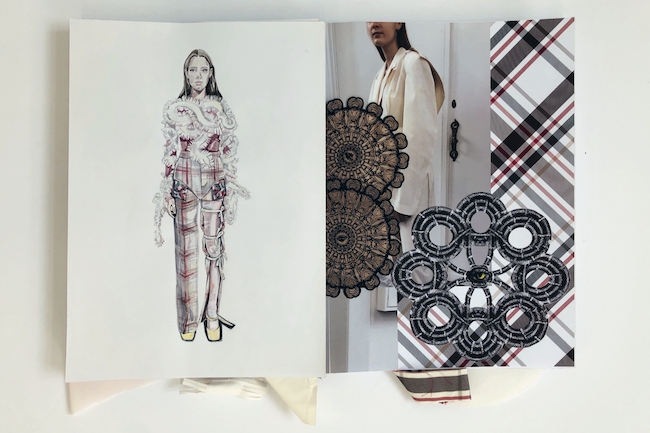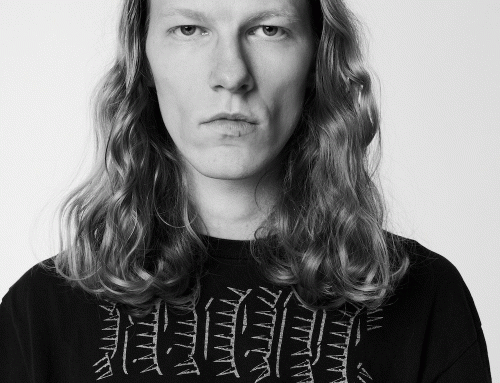Here’s a little taste of what our master students will have on offer for SHOW2019, last by not least are Nick Haemels, Shuting Qiu, David Viersen and Yelizavetta Volosovska!

Nick Haemels
Origin: Belgium
Age: 25
Collection: Between the coloured lines (men’s)
Do you have a method for beginning a collection?
I’m very visually inspired so often it’s about watching a movie or seeing a good artwork. I always start with one little point and then like a snowball everything comes together. With this collection, I saw the movie Ex Machina about artificial intelligence. It’s not a common sci-fi movie, but very polished, and I liked that feeling so I searched for things that fit together with it. I came across cleanroom and anti-static suits and that seemed like a starting point. I also wanted to work with print for the first time this year – I’d always done colour blocking and fabric manipulation – and optical art seemed to tie this research and the film together. I never wanted to work with digital print though. I never felt a connection to it, because in a way it’s easier to do. Going forward, the more I researched artists, the one I liked the most was Sol LeWitt, especially his wall drawings. I just felt the connection with the collection and felt that if I could translate it into print I’d have this really boyish feeling with the colours and lines. I’m painting everything like the linings myself, using a roller on the fabrics, taking the tape away and getting the same print on my clothes. LeWitt’s work is super, super flat and that was important for me. I’m translating his prints in quite a direct way, though I have made some changes to them. I always try to keep respect for the artist.
Your work seems flat at first but at the same time it’s architectural. Slowly you start to have this 3D effect of the clothing on the body. The slicing and cutting reminds me of architect-turned-artist Gordon Matta-Clark cutting shapes in abandoned buildings to give them other perspectives.
I did architecture for a year before so that’s in there somewhere I’m sure. In a way I think my approach to fashion is a bit different because I work more like a product designer or architect in my way of sketching or building things up.
What made you move from architecture to fashion?
I studied interior architecture, architecture and industrial design at Sint-Lucas in Antwerp for a year. I’d always felt really happy with the subject and thought it was the way I wanted to go professionally but then I was there and it wasn’t such a good time for me. I didn’t feel very happy and was looking for something else to do and felt like I needed to do something more artistic at that moment. I still really love architecture – maybe I won’t become a fashion designer, maybe I’ll go back into industrial design.

Shuting Qiu
Origin: China
Age: 24
Collection: I am rooted by i flow (women’s)
You were interested in being a writer before fashion, weren’t you?
Yes. I was very good when I was young and won a lot of prizes. Before, to express myself, it was more about writing and text, and now it’s more visual images. Even if I do research I only remember it visually, it’s faster and more direct. That has totally changed. Actually this collection is sort of a trip for me – it’s like another chance to be a writer. I’ve involved Virginia Woolf and used English-style suits. On the visual side, the inspiration is a visit to Mumbai, which has led to me including hand-crafted pieces, colours and flowers combined with this more masculine cut and the suits. I’ll have this mix of handicrafts and a tartan for the British references.
Why did you choose fashion if you were writing a lot before?
Because I love clothes. I talk with lots of young designers and people can immediately see that I’m really into that. With some designers they really like to create the whole thing – how to do the show, how to do the showroom – but for me I’m more concentrated on the clothes. Going deep with the garments. I see some designers now who don’t do shows anymore. They just do a party or installation to present the concept. I would never do that because I think you need them to show the garment.

David Viersen
Origin: The Netherlands
Age: 26
Collection: Sentinel Chant (men’s)
Let’s talk about the origins of your collection…
It’s not a very cohesive story – you’ve been warned! I was readying V by Thomas Pynchon, which really stuck with me. Everything is set around military interventions and big happenings that were really detrimental for industrialisation. And one person in that story personifies this industrialisation. It’s a really nice tale that relates a lot to the religion in science. Pynchon wrote it when he was 26 – my age – so I thought yes, this is it.
Were there any other influences?
At that time in Paris I also saw an artist, Laurent Grasso, who had one video filmed with a thermal camera. It was a cowboy with a forest fire right next to him. It was beautiful imagery and his notes were talking about the divide between the esoteric and the scientific aspect of our modern lives. Then there’s the music I’m interested in: a lot of Coil, who use ancient imagery, and their name itself is already linked to science. And these small juxtapositions that I also saw happening: Paradise in California was burning, which I found symbolically beautiful. There’s this push in our society, that is aimed at progress, to constantly try to grasp everything in scientific terms, but many previous societies were based on a much more spiritual level, and they also didn’t see their extinction coming. I feel that we’re at this breaking point, at least politically. All this combined and I felt that there was something under the surface that I wanted to delve into.
The funny thing is that we’ve always thought there would be some solid ground, but now we see there isn’t.
That’s the thing. We take scientific principles for granted. I’m not saying the earth is flat but I find it very interesting that there are people right now linked to the alt-right going back on science itself. What we considered science is not science anymore. These things are all so loosely based even if we take them for monoliths of knowledge. Which is beautiful, because nothing is secure anymore.

Yelizavetta Volosovska
Origin: Ukraine
Age: 22
Collection: Snake Charmer (women’s)
Tell us some more on the collection…
I decided to base my collection on a story i created around my own experience, called ‘The Snake Charmer’, a narrative based on something that happened to me last September but I made it mythological. You have the impression of a story but there are no names and places. It’s based on a woman who hears about a man who charms all the women and snakes in the world so they are left with no hope of escape. She decides to meet all the female victims to get their knowledge about how to become the most attractive woman in the world, and then she meets the snakes to become the most beautiful and charming snake in the world. Once the time comes to meet the snake charmer, he tries to seduce her, and he falls in love with her as a snake. Then she takes off her clothes and stands there naked, and he falls in love with her again as a woman. She puts his love in her pocket saying that success is not final, failure is not fatal, it’s the courage that counts – and leaves for her next adventure, which is the new collection itself.
How does the collection tell this tale?
When the woman meets the snakes, they weave around her legs, becoming the stockings on her legs, and they weave through the chequered material I’m using. And when the woman takes off her snake clothing and becomes a human again, that’s reflected in the naked parts of the collection where you can see through the body.
All the linings of the garments are with snakes as well, and most of the materials are super-shiny to translate this richness. In the past I worked a lot with oversized things, and draping, making deformed and asymmetrical things, but this collection is more symmetrical. I don’t want to impress too much with the cut of the garments but try to precisely translate the idea so that everything becomes clear.
Don’t forget you can also take a closer look at each master’s collection in detail at EXPO2019!
Read the full conversation in our official magazine available at the show.
♥ to Nico Dockx for the interviews & Oona Oikkonen for the master portraits










